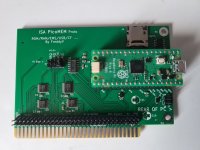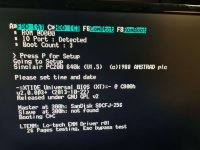Hi there !
I am known (Or not) so far for my Mod Master XT MOD Player and the CH375 ISA to USB Board driver optimization.
Months ago (Almost one year), had the idea to do a board like the PiStorm, but instead of emulation the CPU, pit a Pi on the ISA BUS.
I did not know where to start for it, but after seeing the PiGUS and after, the PicoGUS project from polpo, I finally decided to start my project.
The Idea was to put a Raspberry pi on ISA to be able to emulate anything.
Unfortunately, as the Pi are difficult to find and expensive, I started first with the Pi Pico.
And Here it is :

On this board, I did put:
- Connection to the full Memory and I/O BUS
- One IRQ
- No DMA
- MicroSD Connector
- 8Mb of PSRAM
After some weeks (representing like 4 days full time), The board is able to do this:
- Emulate 128Kb of RAM from the Pico internal RAM (Full speed, no wait states)
- Emulate memory (Blocks of 64k anywhere) and EMS (Up to 4Mb) with 6/8 wait states.
- Emulated ROM (I did run the CH37x BIOS on it)
- Execute commands from the 2nd core.
- Memory and IO Address decoding to redirect the access to different types of Memory/Emulated device
I just start to work on the Compact flash part (2 Pins are reversed so I have to rewrite the SPI in PIO) and the Board BIOS.
The Idea (If and When the SDCard will work will be to:
- Have an auto configuration BIOS able to detect the machine memory and expand it automatically.
- Simulate multiple HDD using DOSBOX Int13h code (The PC CPU will not do anything)
- MAP Disk images (.IMG) and why not all the DOSBOX supported floppy images from the SDCard
- Have 4Kb of RAM in the ROM @ space, so that the BIOS can use RAM for its internal config, plus for fast "Disk" access.
- I already think about lot of speed optimisation/Tricks to have the disk access close to the memory access speed.
- With the Pico W : Network card emulation and so on...
After this prototype, multiple boards versions are possible, even to add sound (Soundcards) support.
Video will not be possible.... but why not doing a PicoVGA or something else based on the Pine64 Ox64 board (Pin compatible with the Pi Pico)
This board can also be used as a base for Diagnostic, code/BIOS debug, real time ISA communication capture (music in .VGM, ...), Co processor....
If you want to follow the project and help me, I did something like minute by minute diary of what I did so far in a Discord server.
This Discord is about the PicoMEM, PicoGUS and PicoPCMCIA projects.
I may not comment/give lot of news here, it is better to follow me in Twitter, or come to the discord. (Full english if you are afraid by french)
Regards,
FreddyV

I am known (Or not) so far for my Mod Master XT MOD Player and the CH375 ISA to USB Board driver optimization.
Months ago (Almost one year), had the idea to do a board like the PiStorm, but instead of emulation the CPU, pit a Pi on the ISA BUS.
I did not know where to start for it, but after seeing the PiGUS and after, the PicoGUS project from polpo, I finally decided to start my project.
The Idea was to put a Raspberry pi on ISA to be able to emulate anything.
Unfortunately, as the Pi are difficult to find and expensive, I started first with the Pi Pico.
And Here it is :

On this board, I did put:
- Connection to the full Memory and I/O BUS
- One IRQ
- No DMA
- MicroSD Connector
- 8Mb of PSRAM
After some weeks (representing like 4 days full time), The board is able to do this:
- Emulate 128Kb of RAM from the Pico internal RAM (Full speed, no wait states)
- Emulate memory (Blocks of 64k anywhere) and EMS (Up to 4Mb) with 6/8 wait states.
- Emulated ROM (I did run the CH37x BIOS on it)
- Execute commands from the 2nd core.
- Memory and IO Address decoding to redirect the access to different types of Memory/Emulated device
I just start to work on the Compact flash part (2 Pins are reversed so I have to rewrite the SPI in PIO) and the Board BIOS.
The Idea (If and When the SDCard will work will be to:
- Have an auto configuration BIOS able to detect the machine memory and expand it automatically.
- Simulate multiple HDD using DOSBOX Int13h code (The PC CPU will not do anything)
- MAP Disk images (.IMG) and why not all the DOSBOX supported floppy images from the SDCard
- Have 4Kb of RAM in the ROM @ space, so that the BIOS can use RAM for its internal config, plus for fast "Disk" access.
- I already think about lot of speed optimisation/Tricks to have the disk access close to the memory access speed.
- With the Pico W : Network card emulation and so on...
After this prototype, multiple boards versions are possible, even to add sound (Soundcards) support.
Video will not be possible.... but why not doing a PicoVGA or something else based on the Pine64 Ox64 board (Pin compatible with the Pi Pico)
This board can also be used as a base for Diagnostic, code/BIOS debug, real time ISA communication capture (music in .VGM, ...), Co processor....
If you want to follow the project and help me, I did something like minute by minute diary of what I did so far in a Discord server.
This Discord is about the PicoMEM, PicoGUS and PicoPCMCIA projects.
I may not comment/give lot of news here, it is better to follow me in Twitter, or come to the discord. (Full english if you are afraid by french)
Regards,
FreddyV






